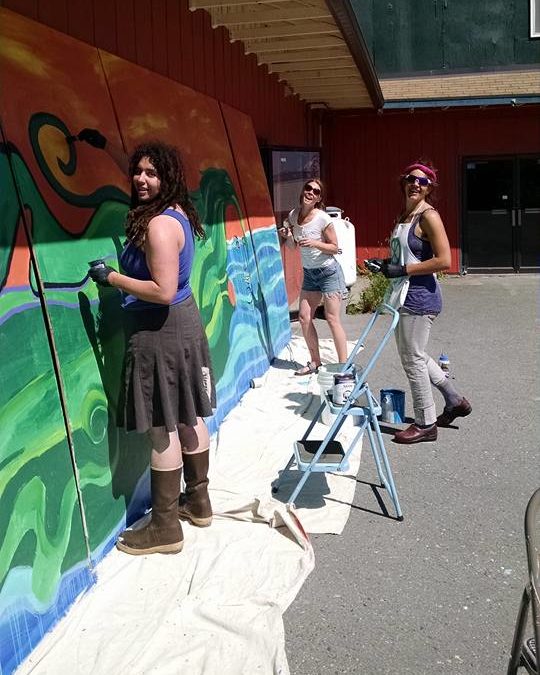What is a small town girl doing in an even smaller town?
by Teaching Muralist Kady Perry
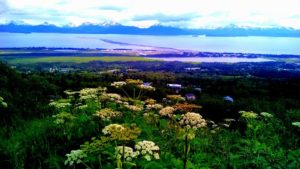 Upon a 5-week pop up mural program on the Kenai Peninsula last month, it is with fervor that I write to you about “Peonies on Pioneer”, a mural project in Homer, Alaska. I will then use this project to give you the recipe for a mural program in your town/city.
Upon a 5-week pop up mural program on the Kenai Peninsula last month, it is with fervor that I write to you about “Peonies on Pioneer”, a mural project in Homer, Alaska. I will then use this project to give you the recipe for a mural program in your town/city.
I was the Bunnell Street Art Center’s June artist in residence. For Bunnell’s residency program, I wanted to innovate upon the traditional residency experience. Often times artists are painting in a studio, creating a series of work that culminates as a final exhibition. For a more compelling proposal, I offered to launch a hyper-local mural program. Typical to what I propose in cities and towns around the country, the idea is to engage local volunteers, train artists via workshops and then come together to paint murals that celebrate the local community. So we did just that and by we I mean:
25+ highly engaged community members.
600+ man hours later.
8 mural sites.
5 weeks.
A collaboration of civic, private and non-profit partners, the aim is to enliven Pioneer Avenue as an economic district, attracting visitors and residents to linger and explore Homer’s historic core. Partners sponsored murals with a peony theme to celebrate and leverage Homer’s assets in the arts, agriculture and recreation. Change out Pioneer Ave for any Main Street Corridor and Homer with any town in the country and you have a recipe for creative placemaking. A way to change the world a little, in your own way.
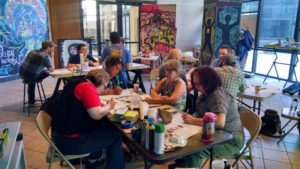 More and more I receive accolades as well as questions on how I do what I do and so here is a bit of insight into the highly complex process of working with a municipal government or arts organization to start a mural program. In developing and designing the first steps go like this: Before you even arrive, before you even write the first draft of your program proposal, research the place. See if cities nearby have ever hosted a successful mural program. Does the program make sense for the place? Is it a place that supports art and is it a place that is conducive to public art making? Your first job is to determine this. Use the internet, pick up the phone and make calls!
More and more I receive accolades as well as questions on how I do what I do and so here is a bit of insight into the highly complex process of working with a municipal government or arts organization to start a mural program. In developing and designing the first steps go like this: Before you even arrive, before you even write the first draft of your program proposal, research the place. See if cities nearby have ever hosted a successful mural program. Does the program make sense for the place? Is it a place that supports art and is it a place that is conducive to public art making? Your first job is to determine this. Use the internet, pick up the phone and make calls!
So—-Did you find the perfect place? Now I will tune you into the time that needs to be invested into your mural project before arriving in the city/town. You have to dig around the internet even more, connect with arts/community organizations, and begin to understand the blank canvas/town. Start your database of contacts. Pick up the phone, draft emails and reach out and connect to those individuals before you arrive. Engage them early, have them sign up for the workshop you designed; you are designing your workshop series in the midst of all of this right? Make it a goal to connect with 10-20 people, leaders in the arts, muralists (if you can find any as often times in cities that you are popping up a program in there are none, but you will find that there is a high demand for training), and active community members. Include the folks that are in city hall meetings and work with the Chamber of Commerce or the local visitor’s center.
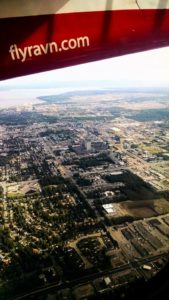 All this, before you arrive—now time to hit the road! Go into the city/town and spend 20% of your timeline getting to know the good, the bad and the ugly of the place. Explore, explore, and then explore a little more. This is one of the most crucial steps, if you abridge this process or don’t do it justice, it will wreak havoc on your programming and minimize capacity building—if it goes too far wrong you might be tarred and feathered out of town. Really.
All this, before you arrive—now time to hit the road! Go into the city/town and spend 20% of your timeline getting to know the good, the bad and the ugly of the place. Explore, explore, and then explore a little more. This is one of the most crucial steps, if you abridge this process or don’t do it justice, it will wreak havoc on your programming and minimize capacity building—if it goes too far wrong you might be tarred and feathered out of town. Really.
Remember all those people you connect with before you got [here]? This is the time to meet those contacts in person. You need to take a fully accessible and open approach or you will not effectively engage a robust cross section of the town. You have a very important job and a hard one at that. Share your passion and vision and most importantly ask questions and listen. Gain an understanding of what your new community is, who they are, what they do, what they want and maybe even find out how they take their coffee.
Now you run your first workshop, which I am sure you included in the conversations previously described. I now dub thee Queen or King Muralist. You are a representative, educator, volunteer, community liaison, and arts advocate. Time to go rally up project sites and watch the magic happen!
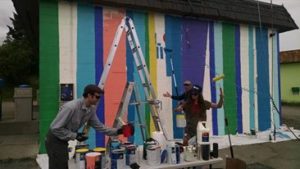 There is, of course, no way to compose a how-to-guide on such a complex process as community public art programming. There are too many nuances, but like the art of baking, I can share recipes, of which you take bits and pieces of (the basics), add in your own touch and thus empower you to bake the cake of a lifetime.
There is, of course, no way to compose a how-to-guide on such a complex process as community public art programming. There are too many nuances, but like the art of baking, I can share recipes, of which you take bits and pieces of (the basics), add in your own touch and thus empower you to bake the cake of a lifetime.
Please keep in mind that community art is therapeutic, sensitive and highly controversial. You are going into a place, painting permanent graphics, colors and images on walls and defining space and place for people that have to live with it for the long term. Way longer then you will have to live with it. So, your role is to catalyze, organize, inspire and change the town in a way that people feel compelled to interact with a space/place they otherwise would have just driven by. To help them slow down a little in life or rather, your job is to change lives.
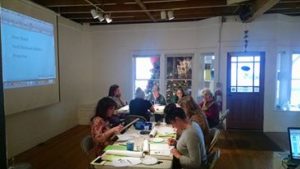 My trip to Alaska, working in a small town of approximately 5,000 reminded me that the real magic truly happens after you leave. Today, only 3 days after returning to New Orleans, messages pour in exclaiming how much [they] appreciate my spark, how inspired [they] feel, how I have brought color and vibrancy to a town that has so much to celebrate but may have needed fresh enthusiasm to reignite the flame.
My trip to Alaska, working in a small town of approximately 5,000 reminded me that the real magic truly happens after you leave. Today, only 3 days after returning to New Orleans, messages pour in exclaiming how much [they] appreciate my spark, how inspired [they] feel, how I have brought color and vibrancy to a town that has so much to celebrate but may have needed fresh enthusiasm to reignite the flame.
Lastly, one might feel overwhelmed at this point. An administrator and business woman, I am also an artist, which means I am emotional. Thinking back on the hundreds of hours. The multitude of people, there are just not enough hours in the day to extend gratitude. The last bit of the recipe, the sprinkles on your cup cake’s frosting, is to write thank you letters.
I want to ensure that I paint a clear picture—no pun intended. Going into a foreign place, stablishing yourself before you get there, and doing it all on a budget and usually scramble-for-time-line is not all sparkly rainbows and unicorns. Ending here with some misconceptions to be addressed at the time you design your project and remembered throughout programming, especially into late hours of the night, when you are exhausted after teaching, painting and running around town all day and open up to a letter of discontent from a community member that does not agree with your line/style of work:
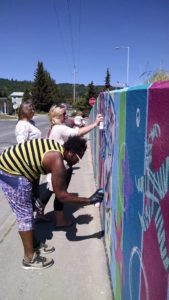 Not everyone is going to like everything you and your crew have painted albeit your first 15 steps of community engagement. You may have felt like you met everyone in the town but, SURPRISE, you did not. More so, you will have people (sometimes a lot) that will vocalize or otherwise express their dislike. Not everyone will be happy with how the project went including yourself as you can never engage the right amount of people or include the entire community! You do what you can, at your best, with the time and resources that you have. There is always more work to do.
Not everyone is going to like everything you and your crew have painted albeit your first 15 steps of community engagement. You may have felt like you met everyone in the town but, SURPRISE, you did not. More so, you will have people (sometimes a lot) that will vocalize or otherwise express their dislike. Not everyone will be happy with how the project went including yourself as you can never engage the right amount of people or include the entire community! You do what you can, at your best, with the time and resources that you have. There is always more work to do.
Now, lather, rinse, repeat.

